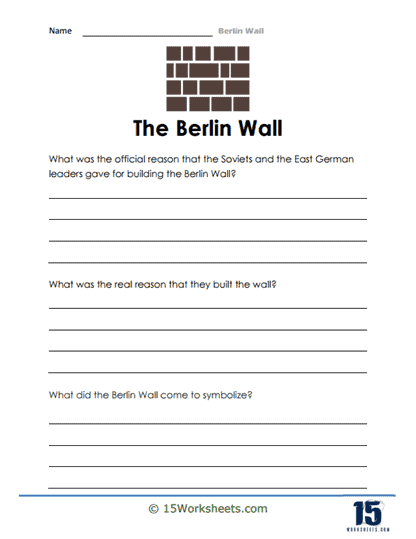Justifications

Worksheet Description
This worksheet delves into the history and significance of the Berlin Wall, an iconic Cold War symbol. It poses three questions that guide students to explore the justifications provided by the Soviets and East German leaders for erecting the wall, the actual motivations behind its construction, and the broader symbolism of the barrier within the context of Cold War tensions. Accompanied by a simple visual representation of the wall, this worksheet encourages learners to critically examine the dichotomy between official narratives and underlying intentions in historical events.
To effectively engage with this worksheet, students should start by researching or reviewing authoritative sources on the history of the Berlin Wall. They should familiarize themselves with the official reasons cited by Soviet and East German leadership at the time of its construction. Subsequently, students should delve deeper into historical analyses and discussions that shed light on the underlying motivations for the wall’s erection. With this comprehensive understanding, they can then reflect on the broader implications of the Berlin Wall, considering its role as a symbol of division, ideological differences, and Cold War tensions.
The primary objective of this worksheet is to foster critical thinking and analytical skills in students by having them differentiate between official narratives and underlying truths in historical contexts. By examining the reasons for the Berlin Wall’s construction, students are encouraged to recognize the complexities of political decision-making and the nuances that often underlie official justifications. Furthermore, the activity promotes an understanding of symbolism in history, prompting learners to reflect on how specific events or structures, like the Berlin Wall, can represent broader geopolitical and ideological struggles. Through this exploration, students gain a more profound appreciation of the intricate dynamics of the Cold War era and the lasting legacies of such monumental events.
